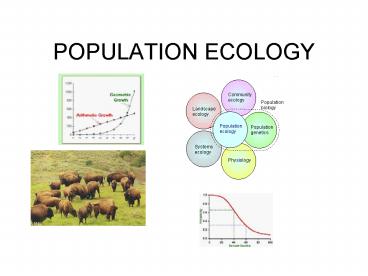POPULATION ECOLOGY - PowerPoint PPT Presentation
1 / 27
Title:
POPULATION ECOLOGY
Description:
POPULATION ECOLOGY ECOLOGY Study of living organisms as groups Interactions between living organisms (predator-prey, parasitism etc) Interactions between organisms ... – PowerPoint PPT presentation
Number of Views:503
Avg rating:3.0/5.0
Title: POPULATION ECOLOGY
1
POPULATION ECOLOGY
2
ECOLOGY
- Study of living organisms as groups
- Interactions between living organisms
(predator-prey, parasitism etc) - Interactions between organisms and their
environments - Study of patterns of distribution and abundance
of organisms
3
Biotic factors
- Biotic factors living organisms affecting
others - Producers, consumers, detrivores, decomposers,
parasite, host, predator, competitor, herbivore,
symbiont and pathogen.
4
Abiotic factors
- Non-living factors (chemical and physical)
- Temperature, light, soil, water, oxygen
5
Populations
- Groups of individuals of the same species living
in the same geographic area - Population ecologists study distribution,
density, rate of growth, demographics (old/young,
male/female) - Data and models used in population genetics and
evolution
6
Communities
- All the populations in a given area
- Interactions and change over time are major focus
of studies - Ecological succession Change in communities
over time, especially after a natural or man made
disruption
7
Primary succession
- Establishment and change in communities in a
completely new environment
8
Secondary succession
- Occurs after a major disturbance ( fire, flood)
9
Ecosystem
- An ecosystem (or ecological system) is a
collection of communities of organisms and the
environment in which they live. - Ecosystems can vary greatly in size. Some
examples of small ecosystems are tidal pools or
the stomach of an individual cow. - Larger ecosystems might encompass lakes,
agricultural fields, or stands of forests. - Ecologists often invent boundaries for
ecosystems.
10
Biomes
- Groups of ecosystems found in specific regions.
- Characteristics are usually determined by abiotic
factors
11
Habitat
- Can be defined as the complete environmental
requirements of an organism for survival food,
water, cover, space, and arrangement
12
Range
- Geographical area where a population is found
13
Niche
- The role of an organism in the community
- Specialists can only survive in specific
environments - Eg Koala, Panda bear
14
- Generalists have large ranges because are not
fussy - Eg rats, cockroaches and humans
15
Trophic structure
- Describes the feeding relationships in an
ecosystem or community. - Describes the abundance organisms in niches and
the of flow of energy
16
(No Transcript)
17
Food webs
18
14.1 Characteristics of Populations
19
Population Density
- Population Density (D)total number of
individuals (N) divided by the area occupied by
the population (A) - Eg If 480 moose live in a 600 hectare region of
Algonquin park, then the population density is - DN/A
- 480 moose/600 ha
- 0.8 moose/ha
20
- Crude density the number of individuals per
unit of space or volume - Ecological density the number of individuals per
unit of area or volume that is actually used by
the individuals. - Eg the moose in Algonquin park do not use the
open lakes. If the 600 ha of the park includes
70 ha of open lake then the ecological density
would be 0.9 moose/ha. - (D480 moose/ (600-70) ha
21
Patterns of dispersion
- Clumped dispersion dense groups in parts of
habitat best suited for survival - Uniform dispersion even distribution
- Random dispersion habitat is uniform, little
competition with other species
22
Measuring Populations
- Methods for estimating population sizes depend on
the organism being studied (range, mobility) - Populations are dynamic so scientists rely on
sampling techniques to estimate the size of
populations - Some sampling techniques are direct (quadrant,
tagging), other are indirect (number or tracks,
nesting sites)
23
Quadrat sampling
24
- Quadrat sampling is usually carried out when the
area under study is fairly uniform, very large,
and or there is limited time available. - Large numbers of samples are taken from different
positions within the habitat.
25
- A quadrat frame is placed on the ground and the
animals, and/ or plants inside it counted,
measured, or collected, depending on what the
survey is for. - This is done many times at different points
within the habitat to give a large number of
different samples.
26
Mark- Recapture Method
- Used for wild animals
- Marking techniques are designed not to harm the
individuals being caught - Timing must be chosen carefully to ensure
accuracy of numbers.
27
- Assumptions
- Every organism in a population has an equal
chance of being caught - During the time between initial marking and
recapture, the proportion of marked to unmarked
remains constant - Population size does not change (increase or
decrease) during the study































